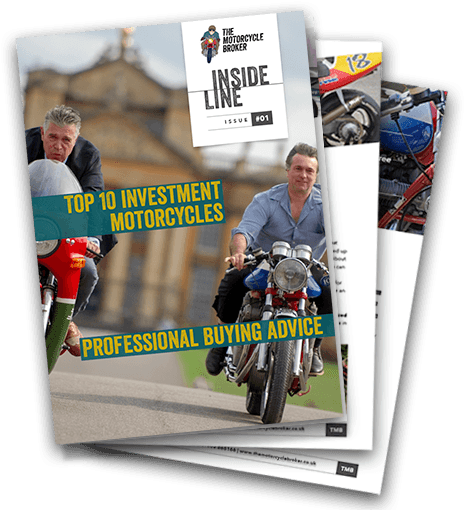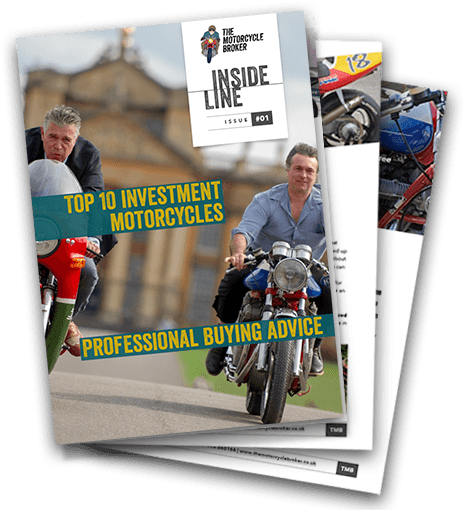THE INDIA ENFIELD CHALLENGE 1999
It’s nine in the morning on Saturday January 23rd 1999, one hundred and thirty people meet at Heathrow airport’s terminal 3 to embark upon a 1,000 KM motorcycle rally. We will be riding Royal Enfield motorcycles through the Ghat mountains in southern India, in order to try and raise £150,000 for Global Cancer Concern. These people range from experienced Fireblade hooligans, to novices who have just overcome the challenge of taking their motorcycle test.
Upon arrival, the disappointment hangs heavily in everyone’s eyes, smothering the excitement and expectation. We’re immediately told that the flight has been delayed by 24 hours. GS Promotions, the rally organisers, have us put up in a hotel at Heathrow, paid for by Air India. The hotel is very old fashioned, lots of hardwood panelling, paintings and prints of unknown British gentry playing polo and riding horses. It has an austere and soulless feeling, as the organisers try a number of contingency plans to deal with the havoc bestowed on their rally schedule. Us riders get to know each other, as the hotel bar grows richer and it seems to me like an interesting group of eccentrics. One woman, who has a strong physical resemblance to the late Lady Di, climbs onto a wooden statue of a donkey, which is in the middle of the room on a raised pedestal, and kick starts it like a motorcycle. Everyone cheers, but the staff are not amused. In blind panic, and not knowing what else to do, one of the bar staff turns out the lights in the bar until she dismounts.
An unscheduled alarm call wakes me on Sunday at 7.00am, a fraught voice on the end of the phone says that we’re on an early flight and have to leave immediately. So it’s off to Heathrow again, only this time we manage to board the plane and take off at 11.00am. Having never travelled outside of Europe before, this is to be my first experience of flying in a 747, which does not live up to my expectations of spacious luxury, in fact the entire eight-hour flight is thoroughly uncomfortable. What makes it even more uncomfortable, than either the feeling of being stuck in a tube train for eight hours, or the pungent smell of a few hundred curries all served up at once, is that one of the rather more rowdy members of the party is nearly arrested in mid-air for stealing drink. He then becomes thoroughly abusive to the airline staff, and most of the party do their best to dissociate themselves from him.
We land in Bombay at about midnight Indian time, and I am feeling excited about the prospect of a culture shock, wondering what my first impression of India is going to be. The real shock is that there is no real shock to the senses to be had at Bombay International Airport. It seems much like any Spanish airport of the 1970s. The plasterboard walls are painted in a sombre grey and white, with polished linoleum floors and fluorescent roof lights. There are long reclined seats covered in sticky, squeaky, plastic, with people stretched out asleep on them. It is very quiet, some people sleeping, others eating, all of them waiting to travel, but I have the suspicious feeling that during the day this place is probably very noisy and chaotic.
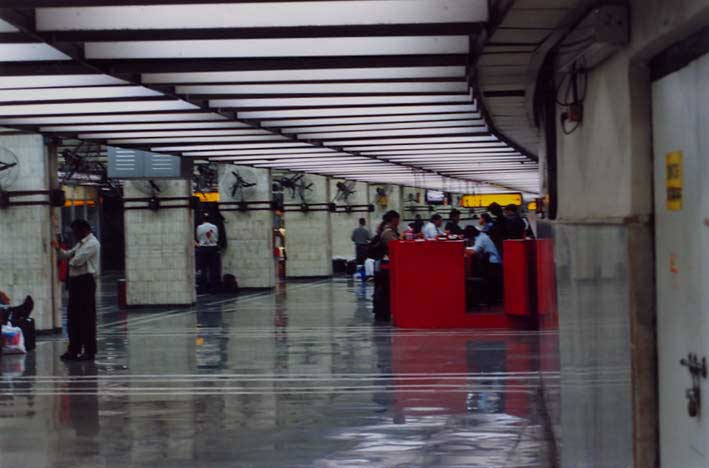
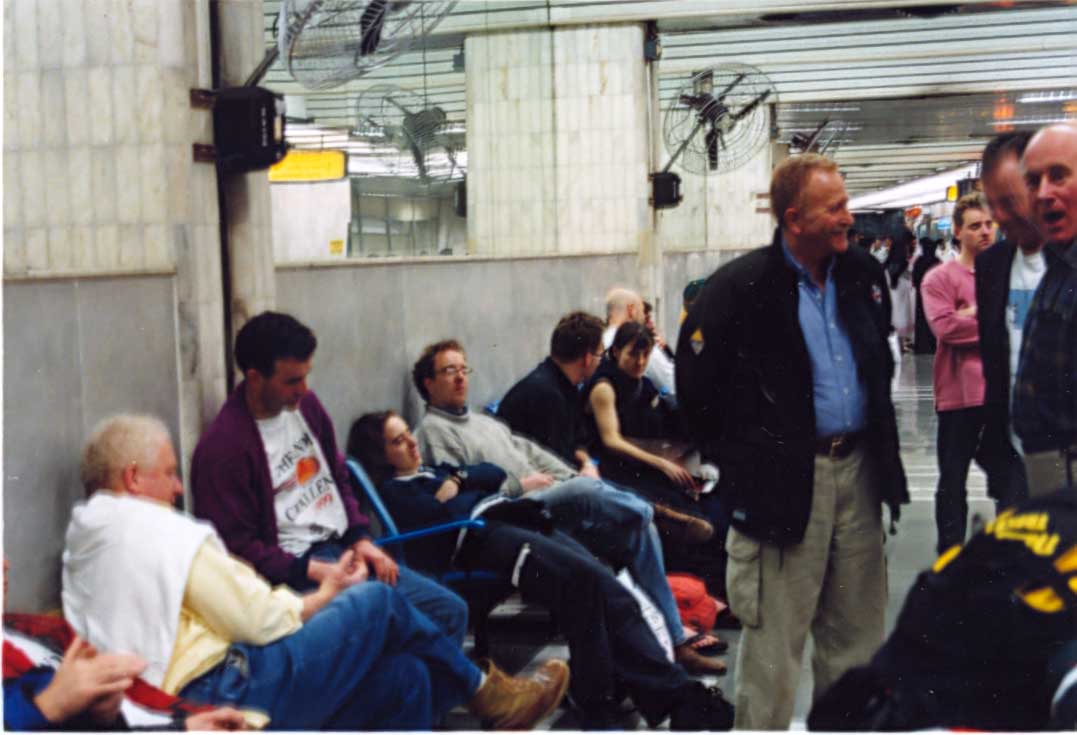
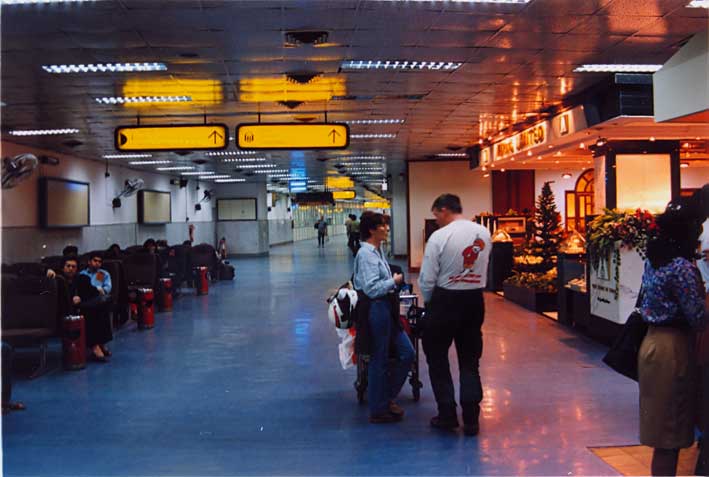
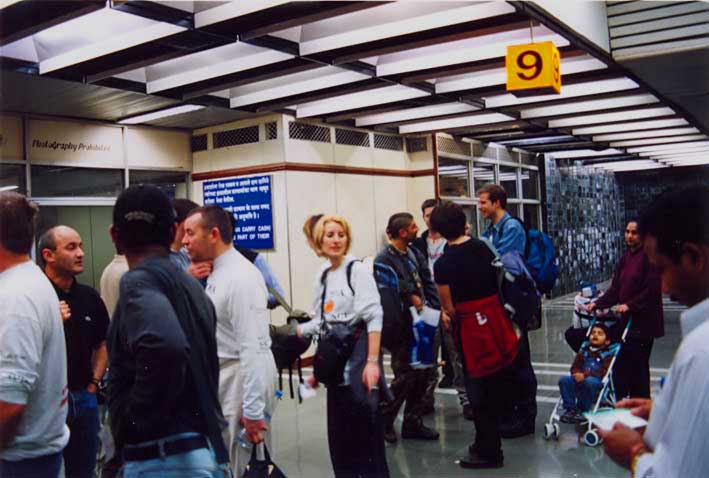
At eight o’clock on Monday morning we board our flight to Trivendrum in Kerala which, prior to even landing two hours later, delivers the dramatic change I had previously been so excited about. From the aircraft just above the runway, I can see what looks like a white palace. It has four turrets that come up into points, like meringues, just like the turrets on the Taj Mahal. There’s the road, which runs parallel to the runway, the sight of rickshaws, old buses, Austin Ambassadors and people buzzing along on old scooters all eliciting excitement to my bones. This is the jolt I wanted so badly, that shouts “Wake up! You know nothing except what happens in your world! Look at this!”
There is a feeling of excitement among our group, which turns rapidly to terror as the plane lands with three loud bounces, feeling as if it’s been dropped from the sky onto the runway, instead of gracefully touching down. Upon entering the airport terminal I am reminded of the movie “Casablanca”, it has a military and serious feel to it. I had once been on a day trip to Morocco when I was twelve and my first impression of southern India is that it feels similar in some ways, such as the reverence and seriousness commanded by the airport officials. These are people with good jobs and their posture demonstrates their pride in such employment. When handing in my passport the officer scrutinises it thoroughly, the same way he examines every passport that is ever passed to him. He takes nothing for granted, because his job is important to him, it’s a matter of pride that it’s done excellently.
Having come from January temperatures in the UK to dusty moderate heat, from European sophistication to utter rawness infused with dated industrialism and the yawning, wakening of commercialism, I find it suddenly necessary to stop for a moment and look at the airport. Here people live uncomplicated, simple approaches to everyday tasks and there’s a definite lack of artifice. For example, the Indian people’s solution to unloading the hold of a plane is to take a tractor, hitch up a series of trailers, put the luggage on the trailers and take them to the terminal. We, however, in Europe tend to do much the same thing, only instead of using an old tractor, go to all the trouble of custom building a special vehicle and special trailers purely for the purpose of unloading aircraft. And, what’s more, is that the luggage retrieval at Trivendrum is noticeably faster than the system in use at Heathrow.
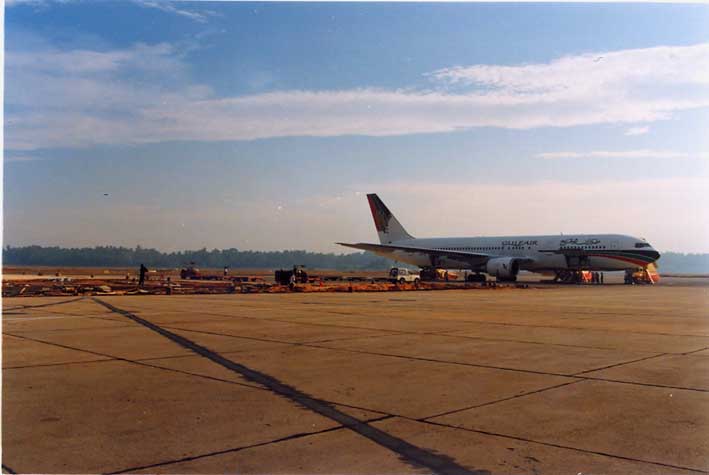
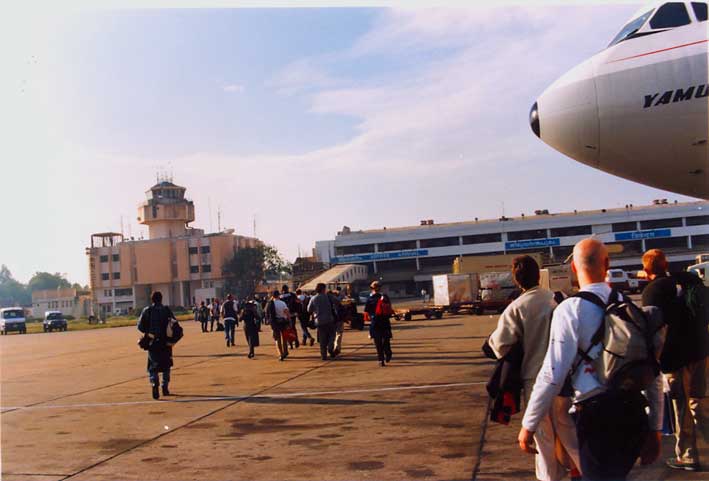
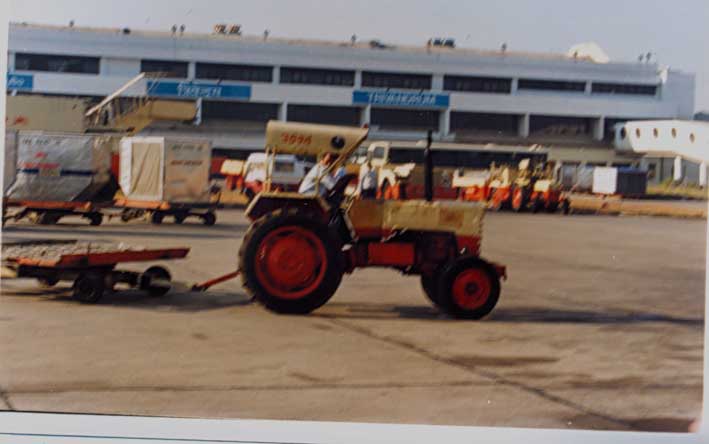
Walking out of the airport building through the crowds of people, the first thing that strikes is stepping into a wall of sound. There is a cacophony of everyone talking at once, and taxis driving through the sea of people, constantly hooting their horns. I shuffle out into the sunlight following one of our group, assuming they must know where we’re going. Fortunately they do, so we congregate in a car park in front of our three coaches, where we are offered a very tasty packed lunch and free bottles of mineral water. Whilst eating my lunch in the sunshine it’s noticeable just how many crows there are in the car park, each competing for scraps of food. There must be at least fifty of them, however they’re noticeably skinny and scrawny, not plump and well fed like our European crows.
Whilst eating a rather tasty fried lentil patty, there comes into the car park a sight I have never experienced before. An Indian man, in white trousers to his knees, and a white top, walking with his hands on top of his feet in a squatting position. His arms and legs are noticeably skinny and fragile, to him we must all seem like fat, lumbering, giants. He approaches each of us one by one making eye contact and holding out his hand. Some offer him their packed lunch, which he declines, I refuse him, and others give him money. He seems to do fairly well out of our particular group, and moves on leaving me to contemplate the implications of people who deform their family so that they are more effective beggars, as this man seems to have been. As I debate in my head whether I should have given him money or not, someone starts playing the bagpipes by the coaches. This is quite a bizarre over load for the senses, and although certainly a mixture of worlds, really quite pleasant. The bagpipes feel like a celebration that we’re well and truly here now.
We get into our coaches and leave the airport, driving along at what feels like James Bond movie car chase speeds, with the drivers constantly sounding their horns. In fact everyone on the road is hooting, our first driving experience is an orchestra of horns, and there doesn’t seem to be an explanation as to why. Maybe today is some public holiday in India, and everyone is so happy that they have decided to exercise their horns all day long; who knows? Our coaches race along as if they’re playing chase with one another. Images flash by, my head whipping round to remain focused for a precious second more. There are some elephants with their legs chained together. Usually such big, regal creatures, but these ones seem to look so sad, stood there by the side of the road. We pass cows lying down by the road, but unlike the ones in Europe, these are skinny and their bone structure forces its image through their skin, out into the world. I realise how fat our livestock is in Europe, hardly surprising that we suffer so badly from heart disease. Every town seems to have a satellite dish visible from the road, and there’s an abundance of advertisements for Fanta, Pepsi, mobile phones with free air time, flush toilets, water pumps, banks, motorcycles and whatever companies think the Indian people will buy. As we race along these images flash before my eyes like watching a film, yet feeling I’m a participant in it, not just a voyeur. We pass women walking erect in their bright saris, carrying themselves with the internal dignity of royalty.
Upon arrival in Kottayam we head for the parade ground at about 3.00pm on Monday, without having slept since London, to a welcome fit for heroes. Garlands of flowers are put around our necks, dignitaries give speeches, an Indian band plays, we are interviewed by Indian MTV, and elephants are ridden into the parade ground for no apparent reason other than to add to the spectacle of the event.
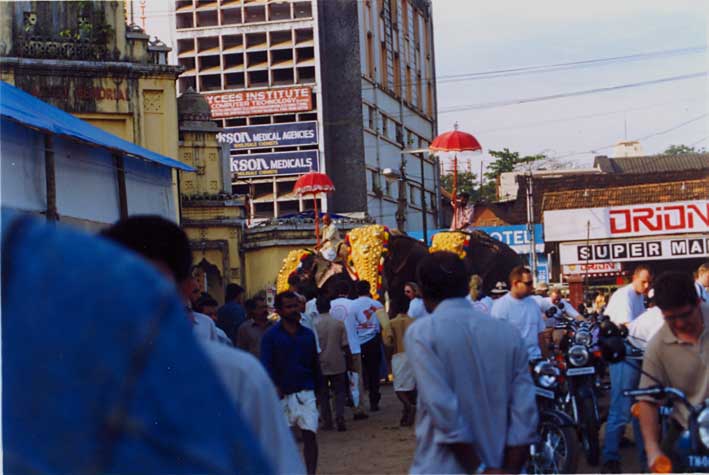
One of the speeches is by a doctor from Global Cancer Concern, enlightening us to the incredible work carried out by them in India. GCCs work is to provide palliative care for terminal cancer patients. They are the only organisation allowed to administer pain relief, due to the opium-based ingredients necessary for analgesics to be effective against the extreme pain associated with cancer.
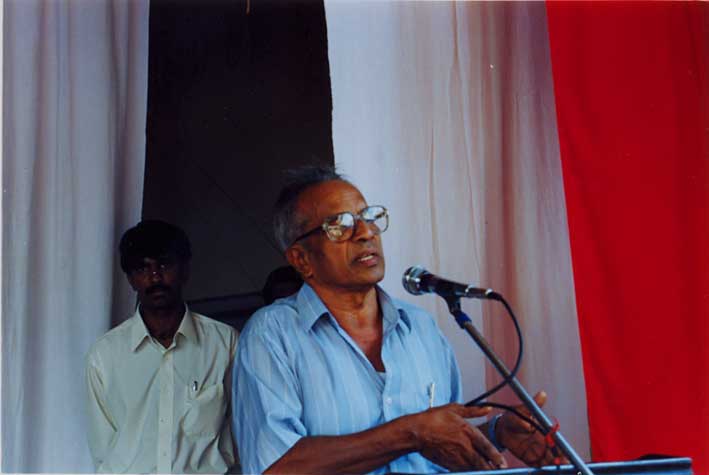
Every year there are one million new cases diagnosed, of which ninety-percent die. Alarmingly thirty percent of these are tumours occurring from the neck up, and although there is no concrete evidence to prove this, because no cancer register is being kept in India except for the GCC doctor’s records, they say that the one common factor linking such cases is the chewing of “paan”. “Paan,” or “Beetlenut” as it’s also known, is a sweet, which is chewed in the belief that it aids digestion. It contains tobacco and is held in the back of the mouth for hours at a time. There is no way of gauging the number of cases related to smoking cigarettes, although the tobacco and marketing companies are doing their best to sell their products to a huge market which is blissfully ignorant to the health risks associated with smoking.
The doctor says that at times, prior to working for GCC, he had felt it necessary to practice euthanasia. For example when terminal cases have been brought to him in agony, with no chance of survival, no treatment, no pain relief, the patient and the family pleading with the him to end their suffering. Now that GCC can administer pain relief this is no longer necessary, allowing people to die with dignity. The doctor’s speech gives me a clearer understanding now of the importance of how one dies. To die pleading for mercy, to be put down like a suffering pet, cheats anyone of the vitally important time of being able to make peace with oneself and anyone else. For anyone to live the end of their life choosing what’s done in that time, how they spend their last days on this planet, to have time to reflect on their life, and to attend to issues unresolved is dying with dignity. Dying in agony takes the choices away, the person just wants it over and done with. I now understand fully the real, ultimate reason for the rally, how much more important this reason is than my own selfish motivations.
Now it’s time to find out which of the 130 brand new bikes is to be my personal steed for the next five days. Lost in the sea of machinery, looking at each rear mudguard for a small sticker with my name on it, I eventually find it. A black Indian specification 350cc Royal Enfield Bullet, so quickly I cover my machine in stickers supplied by my sponsors, so that it’s easily recognisable.
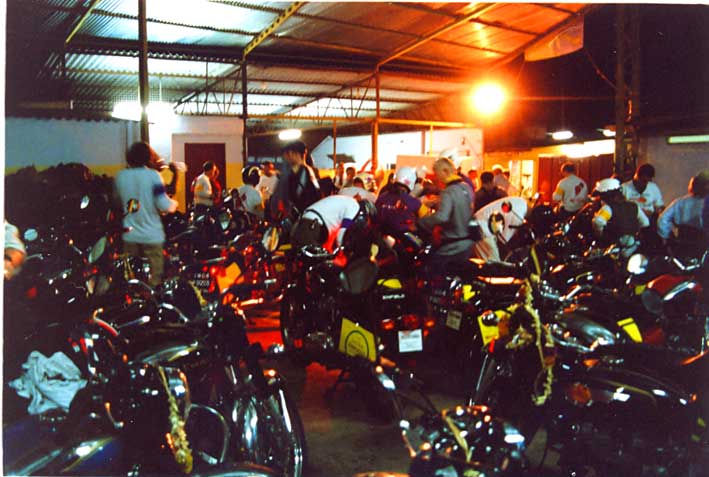
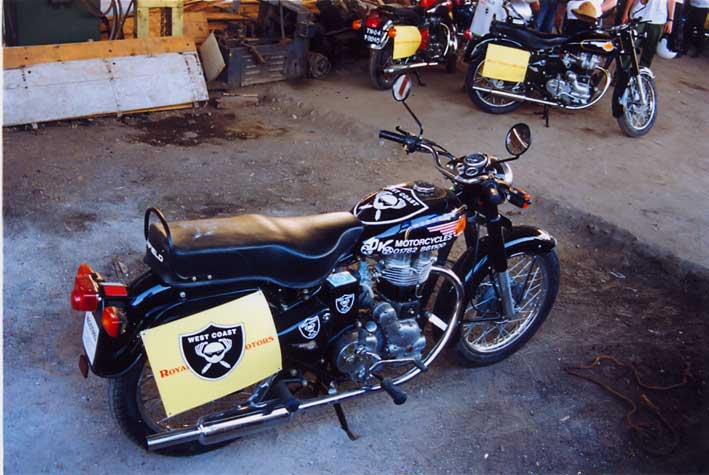
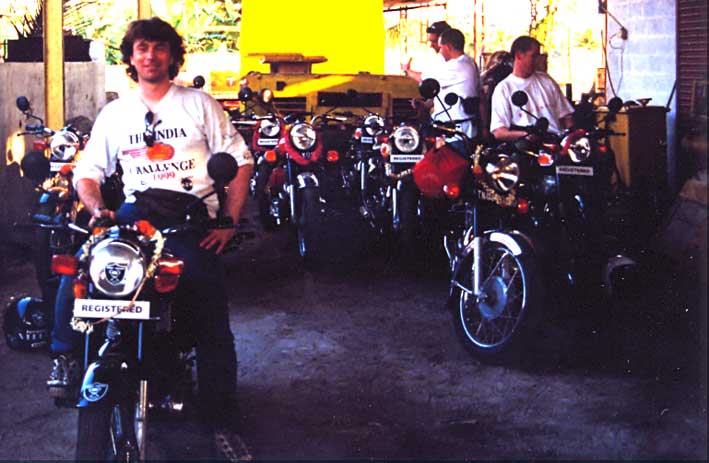
After finding our respective bikes, we set off through Kottayam in procession. The noise is incredible, 130 motorcycles all fired up at once. We ride through the city after more than 36 hours without sleep, I’ve never ridden an Enfield before, and we don’t have a clue as to where we’re going. I’m tired, caught in the haze of a completely different way of life, and astounded at the machines we’re riding. Enfield’s, being of a design dating back to the 1950’s, have the rear brake lever on the left and the gear change on the right with a gear configuration of one up and three down. Most modern motorcycles have the gear lever on the left, the rear brake on the right and a gear configuration of one down and four up. This means that when changing gear it’s all too easy to slam on the rear brake and when trying to apply the rear brake one can end up stabbing at the gear lever, which doesn’t help slow the bike down at all when doing an emergency stop. The front brake also dates back to the 1950’s, which means that the best way to achieve an emergency stop is just to shut the throttle, close your eyes and prey there won’t be an impact. Also the new clutch cables are starting to stretch, which means that every time one of us stops in the city traffic the bike stalls, leaving the rider trying to kick-start their machine as there’s no electric start fitted.
I don’t think many of us have ever ridden in India before, I certainly haven’t, so we also have to contend with the shock of that as well. Indian people seem to drive using the horn as if it’s linked to the brakes and throttle, it’s a constant symphony of different horn sounds and rhythms. There’s also a definite pecking order on the roads. First there’s the bus, which has no indicators and no designated bus stops, therefore stopping abruptly, and without warning, usually after having just over taken you. Then there’s the truck, these are usually painted very bright colours with intricate designs depicting different deities, some are of Mary or Jesus, and others are of Muslim icons. They usually drive wherever they want to and however they wish, so it’s no surprise if a truck driver sees you and pulls out in front of you any way. Then there’s the jeep, which will drive at any speed it feels like, overtake wherever it can and push you onto the dirt track at the side of the road if necessary. Then there’s the car, which is marginally less of a hazard than the jeep, only because it’s slower. Then there’s the lowly motorcycle, the cyclist, the pedestrian, the horse, and the dog, the sheep and so on. Although I’m not sure where cows fit into the pecking order and being sacred, what happens to motorists who run one over?
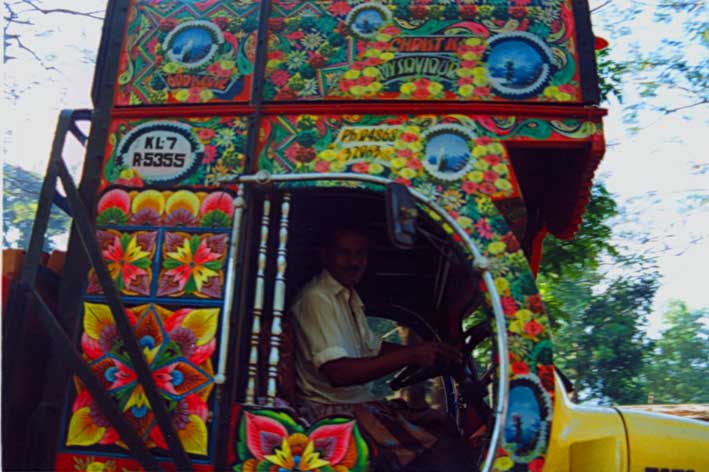
To survive on Indian roads it is necessary to ride in an assertive manner claiming whatever tarmac you can, otherwise it’s a case of “see you on the dirt track by the side of the road”. Although one can still end up on the dirt track, if an on coming truck or bus decides to overtake another vehicle, irrespective of your presence. I still can’t work out what all this hooting is about.
After doing a circuit of the city we make it safely back to the parade ground without incident, except for regular engine stalls and starting dramas. In his crisp, green, official, uniform a policeman waves us past the parade ground without instruction, except for a wave in a vague direction and a wobble of his head. Somewhat confused, I continue to follow the person in front of me who has no idea where we’re going, but just drives until we come across an Enfield shop, which is fortunately our parking place for the night anyway. We drop off our bikes feeling a little shell-shocked, and have a few beers before dinner. The beers are cold, comforting, served in thick glass, one litre bottles, it’s a light, strong, lager that re-hydrates and effervesces on my parched throat, later causing extreme drowsiness. I know that this is one of the best beers I’ll ever drink in my life. I’ll remember this beer as I reach the end of my life and it all flashes before my eyes.
We finally make it to the basic yet comfortable hotel, three people to a double room with one person sleeping on the floor. There are about four thousand mosquitoes to each person, but I’m too tired to care, sleep is more important than being eaten, and why doesn’t this mosquito repellent work?
PART 2 will follow shortly. The blog will continue with one blog per day of the rally.
- 1974 Ducati 750SS green frame genuine factory paint - March 21, 2024
- Unicorn rare 1972 Kawasaki Z900 coming to auction - March 21, 2024
- Ducati green frame is not green it’s blue - March 20, 2024






